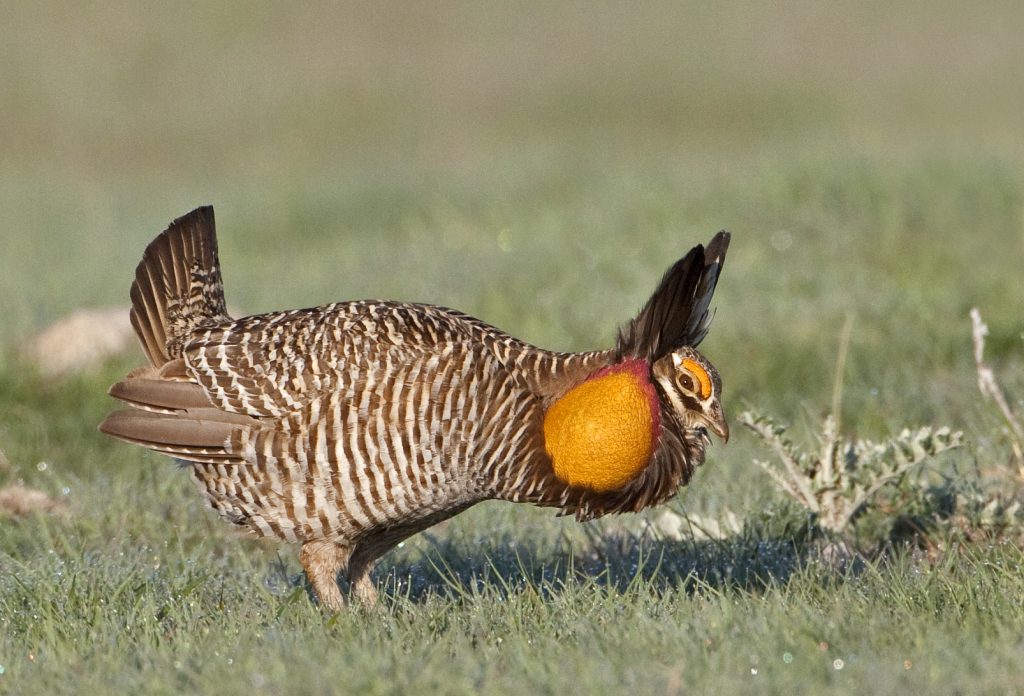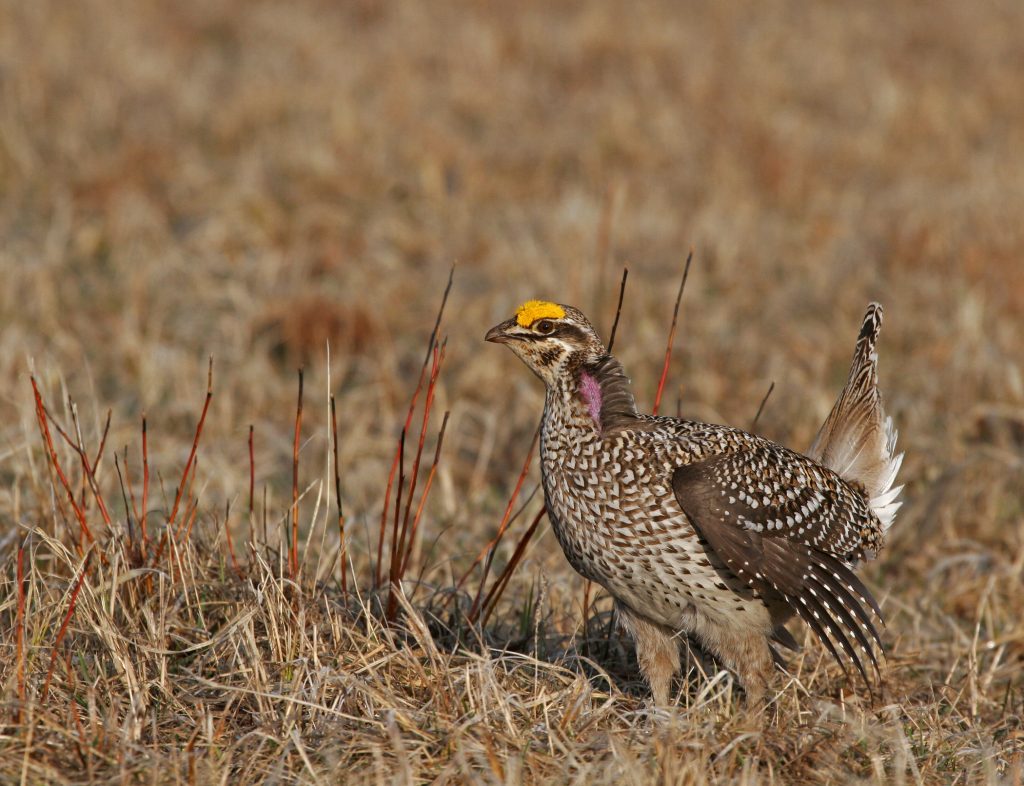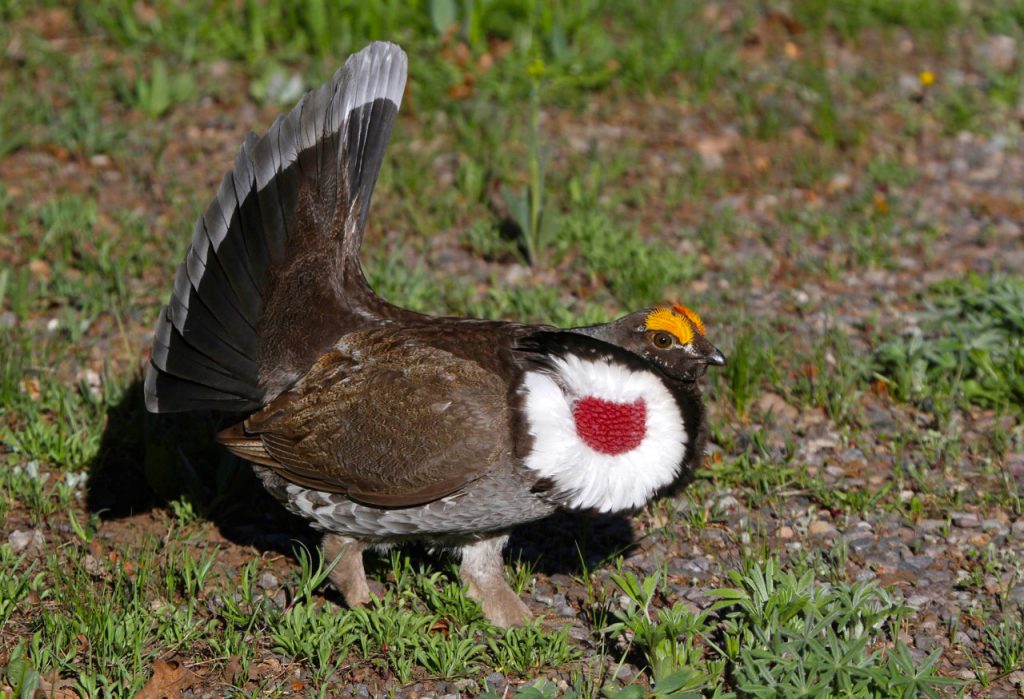Colorado Chicken Run Photo Workshop Itinerary
Dates: 24 April – 4 May, 2019
Day 1:
Arrival at Denver International Airport (DEN) departing westward once everyone has arrived. Depending upon the group’s arrival times and weather at the pass, we hope to make our first attempt for White-tailed Ptarmigan this afternoon.
Day 2:
After breakfast, we’ll journey uphill to the majestic Loveland Pass in pursuit of White-tailed Ptarmigan again. Still attired in angelic white even this late in the Spring, these dapper “chickens” are permanent residents in the higher reaches of Loveland Basin.
In the afternoon, we’ll backtrack through Denver and head for the Pawnee National Grassland to shoot some of the beautiful Longspurs and Lark Bunting. Chestnut-collared and McCown’s Longspurs plus Lark Buntings are setting up territories and giving their unique song flights. Night Greely.
Day 3:
We will rise early today and return to the Pawnee to work on more images of grassland species. As the light gets too high to shoot we will drive toward Wray. A ranch near Wray has one of the most accessible Greater Prairie-Chicken leks in Colorado. Will will have four sessions with the Greater Priaire-Chickens to allow us the capture portraits, action, video and whatever else you desire. Having four sessions allows us to have backup time with these amazing birds in case of any bad weather moves through. Night Wray.
Day 4:
Today we will be up very early to be in our blinds before dawn. For the next several hours we will photograph Greater Prairie-Chickens to our hearts content! Their wonderful displays and antics, fights, and threat displays make for a never ending variety of still and video imagery. After a mid-day break we will return to the lek for our third session with the Chickens. Evening session usually have more subdued displays and action but you never know what will happen. Night Wray.
Day 5:
A final morning with the Greater Prairie-Chickens and we will head to Walden and our first encounter with the Greater Sage-Grouse!
Day 6:
Following our now well established pattern of rising before sunrise, we’ll return to our Greater Prairie-Chicken lek to enjoy the manic sunrise activities of these prairie grouse. One final intimate experience with these vanishing symbols of America’s Great Plains.
After breakfast, our travels take us north and west crossing the Pawnee National Grasslands. Habitats change a bit each mile and we’ll be in search of Mountain Plover, Golden Eagle, Prairie Falcon, Burrowing Owl, McCown’s and Chestnut-collared Longspurs and a host of possible migrants.
Late afternoon finds us climbing through foothills to reach the charming North Park village of Walden. As we ascend, our surroundings quickly change as do our birds. After a quick stop to view American Dipper we’ll continue upward into the mountains. These transitional foothills enroute to montane forest hold Red-naped and Williamson’s Sapsuckers, three species of nuthatches and Mountain and Western Bluebirds, among others. Hopefully we’ll arrive in at our hotel in time for a short drive to view a collection of bird feeders that have been good for rosy-finches in past years. An after dark search for Boreal Owl and Northern Pygmy-Owl is likely. Night Walden
Day 7:
Only the pre-dawn darkness greets us as we arrive atop a sage covered hilltop that Greater Sage-Grouse have declared perfect for their lek. Weather cooperating, we should be treated to an amazing show by these large, somewhat odd looking birds. While their displays aren’t as manic as the closely related Gunnison Sage-Grouse, they remain a riveting spectacle.
After breakfast we’ll tour North Park visiting several lakes & water impoundments that my be bustling with a surge of newly arrived Spring migrants, wet grasslands and sage covered hillsides that may hold their own migrants. The journey around North Park is quite scenic. Along the way, we should be able to locate Sage Thrasher, Townsend’s Solitaire and Mountain Bluebird with other possibilities including Dusky Grouse, Clark’s Nutcracker, Evening Grosbeak, Red Crossbill and Pine Grosbeak. This part of North Park is also the best area in Colorado to view Moose. With luck we may see several of these decidedly odd creatures before our day ends.
If there is sufficient open water, we may see Cinnamon Teal performing their first courtships of the Spring. There is great potential for migrants and mountain birds before returning to North Park. Another after dark search for Boreal Owl and Northern Pygmy-Owl is possible if necessary. Night Walden
Day 8:
As the sun brightens the forest around Walden, we’ll visit nearby feeders hoping for Brown-capped, Gray-crowned and Black Rosy Finches. Many resident birds will be in full song with Pine Grosbeak, Mountain Chickadee, Pygmy Nuthatch and Cassin’s Finch leading the way.
The balance of our day has several options, depending upon what birds we’ve seen and what kind of weather the region has enjoyed this early Spring. Lunch may be a picnic atop a windswept pass or at the head of a sage brush covered valley. What’s promised is fun birding and a good time! Night Craig
Day 9:
Pre-dawn departure toward Hayden whose hills and valleys harbor Dusky Grouse, Greater Sage-Grouse and Sharp-tailed Grouse. We’ll begin by searching traditional areas for Dusky Grouse before visiting a nearby lek of Sharp-tailed Grouse. Much like Greater Sage-Grouse, Sharp-tailed Grouse are frantic, energetic and vocal during their displays—even more so! Everyone witnessing their antics enjoys the show. While it may be hard to leave these charismatic birds, we must soon begin our drive west and south.
Thankfully, changing scenery and birding stops make the drive an enjoyable one and we’ll search wetlands and water areas for Cinnamon Teal and Barrow’s Goldeneye en route to lunch near Rifle. We’ll enter the White River National Forest seeking Pinyon Jay, Bushtit and Juniper Titmouse after we enjoy our lunch.
Our final birding break is a beautiful desert canyon near Cameo where we can search for the elusive Chukar. A short hike through scenic Coal Canyon may produce Black-throated Sparrow, Rock and Canyon Wrens, Gray Flycatcher, Lazuli Bunting or Wild Horses! Night Grand Junction.
Day 10:
Our return to the desert canyons near Cameo won’t begin until the eastern skies have begun to brighten. Recent years have shown that a sunrise visit to these beautiful, rocky canyons produce good experiences with the oft-difficult-to-find Chukars. (Last year’s tour found nine, several that allowed themselves to be photographed!) Departing the high rock walled canyon, we’ll travel over the scenic Blue Mesa with a chance to find several montane species of interest—Clark’s Nutcracker, Williamson’s Sapsucker and Pygmy Nuthatch among others. As we travel off of the mesa, we’ll be greeted by fabulous views of the Gunnison Basin and one of Colorado’s most reliable locations for Lewis’s Woodpeckers. We continue to Montrose, Colorado, gateway to Black Canyon of the Gunnison National Park where we’ll have a late afternoon visit to search for Dusky Grouse. Night Montrose
Day 11:
After breakfast, we’ll travel a short distance to the impressive Black Canyon of the Gunnison National Park. The canyon scenery, particularly from overlooks suspended above the canyon, is spectacular beyond belief and there are few places where it’s easier to find Dusky Grouse—the Rocky Mountain split from Blue Grouse—Pinyon Jay and Juniper Titmouse from established paths and roadways. Weather allowing, we’ll enjoy a picnic lunch in the park. After lunch, we’ll travel through the heart of the Curecanti National Recreation Area. Home to Blue Mesa Reservoir (Colorado’s largest body of water) and Morrow Point Reservoir (origin of the Black Canyon), the area usually holds a variety of waterbirds and shorebirds.
Along the way we’ll stop at Monarch Pass for one last look for montane birds like American Three-toed Woodpecker, Clark ’s Nutcracker, Pine Grosbeak and Red Crossbill. Our journey to Dillon will be broken by birding, a lunch break and to stretch our legs. Night Dillon
Day 12:
After breakfast, we’ll have several options depending upon which birds we may still need to see. We’ll have time to search for White-tailed Ptarmigan at Loveland Basin if previous visits resulted in no sightings, a final search for Dusky Grouse should we need one or for a leisurely walk in search of Spring migrants in one of Denver’s many foothill parks. The Tour concludes at Denver’s airport about 12:00 noon with plenty of time before your departing flights.
Leader: Kim Risen
| Intro | Itinerary | Tour Pricing & Information | Photo Gallery | Birdlist | Registration |






